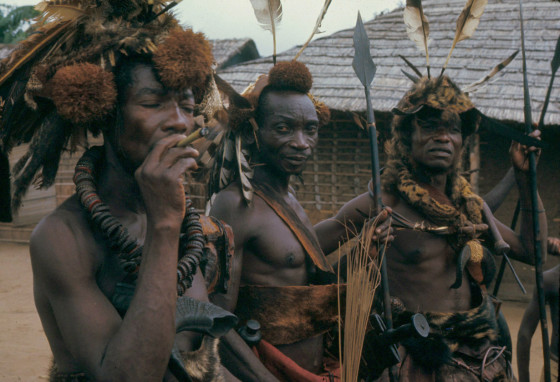If you think pompoms are whimsical, think again. This photograph, from the remarkable Eliot Elisofon Photographic Archives at the National Museum of African Art, shows titled soldiers known as iyol, who have earned the exclusive right to wear pompoms on their hats. [1]
Elisofon, the famously colorful American photojournalist and filmmaker, traveled extensively around Africa between 1947 and his death in 1973. He bequeathed his invaluable archive of 80,000 images of African life, along with his collection of African art, to the Smithsonian. His documentary photographs of artists making things, including textiles, carved masks, and hats like this one, are a fascinating resource for art historians.
The simple four-lobed laket hat is the most common type of headwear among adult Kuba men, adopted after completion of initiation rites. Typically the hats have only small amounts of embroidery or openwork designs. Further embellishments such as raffia pompoms, cowrie shells, beads, animal skins, or feathers, as seen here, are added to this basic form as additional titles or honors are conferred.
[1] Patricia Darish and David A. Binkley, “Headdresses and Titleholding Among the Kuba” in Crowning Achievements: African Arts of Dressing the Head, ed. Mary Jo Arnoldi and Christine Mullen Kreamer (Los Angeles: Fowler Museum of Cultural History, 1995), 165.
This hat is on view in the exhibition David Adjaye Selects: Works from the Permanent Collection, along with thirteen other pieces from the museum’s African textile collection.
Susan Brown is Associate Curator in the Textiles Department at Cooper Hewitt, Smithsonian Design Museum.

